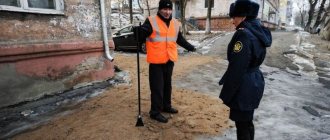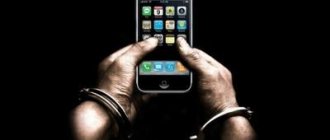Analysis of judicial practice
If you look for judicial practice under Article 196 of the Criminal Code of the Russian Federation, you will be surprised how little there is. That's right: proving deliberate bankruptcy is a very problematic thing, requiring certain qualifications both in law in general and in economic matters in particular. Therefore, law enforcement agencies often take the easier route - they reclassify such cases under the rubber-stamp article of “fraud.” But nevertheless, it cannot be said that the article for deliberate bankruptcy does not work at all.
Here's an example:
Roman had his own individual entrepreneur, which was engaged in retail trade. In September 2010, Roman entered into two loan agreements with Pavel and received $461 thousand.
A month after receiving the money, Roman began to consistently remove his property from under attack: he gave his daughter a plot of land with a house, sold 4 cars and divorced his wife.
Without receiving any payments, the creditor decided to act and went to court. Task: to collect money from Roman under the loan agreement, taking into account accrued interest. In the summer of 2011, the court granted the claim, but Pavel never saw the money - Roman was already homeless by that time.
Then, in the fall of 2011, the creditor filed an application to declare Roman bankrupt. The decision was correct, especially since Pavel had information about the alienation of assets.
Then the situation developed according to the standard pattern: the court accepted the application, the arbitration manager entered the scene, and began to unearth Roman’s machinations. It was then that all the sales and donation transactions came to light. Let us remember that donation is one of the lousiest ways to protect assets, and even more so when it is done in a careless manner.
The manager did not think for a long time and filed a statement with the Department of Internal Affairs, and they, in turn, opened a criminal case. The basis for the initiation was the withdrawal of assets by Roman, which was qualified as deliberate bringing to bankruptcy.
The debtor dodged as best he could: it was not the first time he took money from Pavel, and that he was ready to pay, but it just didn’t work out with the business. In general, the loan agreement dated 2010 is a prolongation of other obligations undertaken back in 2003. As for the gift, it was a gift for her daughter’s wedding, and she certainly could not have known about her father’s debts.
And in general, everything could go according to the standard scenario: application - table - survey - refusal to initiate a case. If it were not for the activity of the creditor and the arbitration manager.
And yet, the outcome of the case was largely decided by the witnesses interviewed, who voiced the following:
- When issuing the loan, Roman and Pavel discussed that the funds were being issued for business development. If the business does not work out, the property - a plot with a house - will go to Pavel to pay off the debt;
- The plot of land along with the house was donated to the daughter, after which she resold everything to her distant relative for 900 thousand rubles. After several trials, it turned out that half of the land and the house already belonged to Roman’s ex-wife;
- It is undeniable that transactions for the sale and donation of property were carried out with the aim of avoiding the payment of debt. The debtor could not forget about debts amounting to almost half a million dollars in a month. Despite the fact that when making these transactions, he assured Pavel that everything would be fine and he would pay everything.
As a result, the court found Roman guilty and sentenced him to 3 years in prison.
But half a million dollars is an amount that can work wonders, so the story doesn’t end there.
The court took into account that Roman was given a positive description by his relatives, there were no similar violations, his elderly mother was dependent on him, and reduced the degree of punishment to 3 years probation.
But that's not all. Referring to paragraph 9 of the Resolution of the State Duma of the Russian Federation “On declaring an amnesty in connection with the 70th anniversary of Victory in the Great Patriotic War of 1941-1945,” the court decided to remove Roman’s punishment and criminal record and did not even impose a fine.
If you are interested in reading all the details of this case, leave your email below and we will send you the verdict in this case:
In general, the story ended more than successfully for Roman. But not everyone is so lucky.
Lawyers have a golden rule: it is easier to prevent a problem than to solve it. And this clearly works in criminal trials: 99.7% of indictments result in an affirmative verdict.
Therefore, the only correct goal when charging with deliberate bankruptcy is to prevent the initiation of a criminal case. I will show you how we at Igumnov Group cope with this task using the example below.
Fictitious bankruptcy (Article 197 of the Criminal Code of the Russian Federation)
This crime consists of actions involving a knowingly false public announcement by the head or founder (participant) of a legal entity of the insolvency of this legal entity, or by an individual entrepreneur of his own insolvency, which subsequently caused major damage. In this case, there are no grounds for bankruptcy, but the entrepreneur announces this procedure in order to avoid any debts, penalties, sanctions, etc.
Signs of fictitious bankruptcy
The person realizes that by publicly declaring his insolvency, he is solvent, foresees the possibility or inevitability of causing major damage to creditors and desires this. Criminal liability for fictitious bankruptcy arises when the purposes of committing this crime are:
- suspension of the procedure for foreclosure of one's property;
- misleading creditors to obtain a deferment;
- installments or discounts on payments due to them, etc.
Our case
I handled the personal bankruptcy case of the director and part-time founder of a number of organizations. Let's call him Oleg.
Oleg was the beneficiary of the plant and several dozen smaller companies.
The plant signed an agreement on the supply of products with one of the creditors, Kirill. Let's say they were bicycles. The products were delivered, but the plant was unable to pay the obligation. The supplier went to court.
The parties entered into a settlement agreement, which the court approved on the following terms: the plant returns half of the bicycles, obligations to pay the balance are transferred to one of Oleg’s companies, and Oleg acts as a guarantor.
A payment schedule was drawn up, according to which not a single payment was made. Since the new debtor never had any assets, trying to collect the debt from him was useless - even bankruptcy would not help. But there was something to take from Oleg, so in 2016 Kirill filed for his personal bankruptcy.
And whoever initiates the procedure calls the tune. In particular, Kirill assigned a supervised manager to the procedure, who began to dig for our client.
When can bankruptcy of an individual be rejected?
Practice shows that courts generally suspend applications received from creditors represented by official bodies. Mostly from the Federal Tax Service. As an example, we can point to case A70-21590/2018 dated January 11, 2022, which was considered in the Autonomous Court of the Tyumen Region.
The applicant was representatives of the Federal Tax Service who applied for recognition of the bankruptcy of the entrepreneur Nasonov O.S. with a debt of more than 1.5 million rubles arising from the taxes of the represented individual. Actually, the court decided to suspend the submitted application for the following reasons:
- The Federal Tax Service did not publish its intentions to the EFRSB within 15 days before submitting the application;
- The Federal Tax Service did not deposit 25,000 rubles into the deposit account as remuneration for the financial manager;
- The Federal Tax Service did not send a copy of the application to the debtor;
- The Federal Tax Service did not send a copy of the claim to the SRO AU.
In fact, the government body committed “childish” violations when initiating bankruptcy proceedings for an individual, and it should be noted that such violations are observed very often. Something similar was observed in Case No. A27-30564/2018 dated April 4, 2022, where the initiator was also the Federal Tax Service, which “forgot” to submit a number of documents to the court, which resulted in the suspension of the bankruptcy case.
Free consultation on debt relief
Leave your phone number, a specialist will call you back within 1 minute
Friendly Lenders
As part of the restructuring procedure, the manager performed a financial analysis and identified dubious transactions of the debtor. These transactions formed the basis for the statement of commission of a crime under Art. 196 of the Criminal Code “Intentional bankruptcy”.
The FU proceeded from the following: all of Oleg’s personal debts consisted of guarantees. Oleg owed almost a billion on bank loans that the plant took out. And Oleg’s other companies have accumulated the same number of commitments. In both cases he acted as a guarantor.
But! Oleg vouched for the credit institution back in 2012, and for his companies in 2014-2015 - after it was obvious that the plant would not repay the debt to the bank. At the same time, the companies whose obligations Oleg guaranteed were objectively empty. For example, one did not submit reports, and according to the other, information about the unreliability of the legal entity was entered into the Unified State Register of Legal Entities. director's address and details. What kind of guarantee for hundreds of millions can we talk about if the legal entity is actually dead?
Since these transactions did not make any economic sense, the financial institution concluded that their only goal was to artificially increase accounts payable in order to dilute the share of real creditors and subsequently reduce payments in their favor. We wrote in detail about how this happens in the article “A Friendly Creditor in Bankruptcy.”
The FI's suspicions were supported by transaction figures. Guarantees for friendly creditors exceeded the demands of enemy creditors by exactly... 100 thousand rubles. The situation looked something like this:
Enemy creditors: 1 billion rubles = 49.0009%
Friendly creditors: 1 billion 100 thousand rubles = 50.0001%
And as you remember: the concept of “deliberate bankruptcy” includes not only the actions of the debtor aimed at the direct withdrawal of assets, but also “actions of an indirect nature aimed at creating insolvency.” The latter is precisely what is meant by the debtor artificially increasing his accounts payable.
At the same time, all of Oleg’s friendly creditors were included in the register of claims, which means they had a majority of votes at the creditors’ meeting. And the right to receive a little more than half of the funds from the future bankruptcy estate. A majority of votes of 0.0001% gave Oleg the opportunity to influence the bankruptcy procedure, even if there was an enemy manager.
For opponents, such excavations are a big jackpot. Inspired and encouraged by the creditor, the financial institution wrote down its conclusions in a financial analysis and sent an application to the Department of Internal Affairs.
Features of the investigation
What should the investigator establish?
Having initiated a criminal case, the investigator must establish:
- whether the company really cannot pay its monetary obligations;
- whether the actions of the manager or owner caused major damage (more than RUB 1,500,000);
- whether there was intent to commit deliberate bankruptcy.
Investigative actions
To obtain evidence, the investigator will conduct various investigative actions: interrogations, searches.
First he will talk to the victims to find out the extent of the damage. Some investigators complicate their task by recognizing not the bankrupt company itself as a victim, but its creditors. This leads to significant difficulties in the investigation. After all, in such a situation, the investigator needs to request and attach to the case evidence of the validity of the claims of all these creditors, and interrogate their representatives. And this is a lot of work. An experienced investigator will recognize the bankrupt company as a victim, and will involve creditors in the process as witnesses.
Then the investigator will interrogate the employees of the bankrupt company. Here are the questions he can ask: who hired them, supervised their activities, gave orders to carry out certain operations; what complaints were received from clients or creditors; what, in their opinion, is the reason for the company’s insolvency, etc.
The investigator will try to obtain as much information as possible. People in uniform can seize documents reflecting dubious transactions not only from the bankrupt enterprise itself, but also from its business partners.
It should be borne in mind that government officials will check information and documents as of the date of filing the application to declare the company bankrupt, as well as for a period of at least a year preceding this date.
note
The most difficult thing is to prove that the accused acted intentionally. The manager can always claim that he predicted the situation incorrectly or made a miscalculation. It is quite difficult to refute his words.
For this reason, most criminal cases initiated under this article are terminated at the preliminary investigation stage.
Defense strategy
Considering that cases of deliberate bankruptcy are usually based entirely on financial analysis data, the defense strategy we chose was aimed at the total destruction of this evidence in the case. To do this, several sequential tasks had to be solved:
Stage No. 1. Restructuring procedure
At the moment, the procedure was being carried out by an enemy AU, so there were several areas of work here:
- We find violations in the analysis made by the financial institution and send a complaint to the court with a request to recognize it as inconsistent with the calculation methodology established by the by-laws.
- While the court is considering our complaint, we convey to the investigator our position that it is impossible to put this financial deposit. analysis into the basis of a criminal case in connection with its subsequent recognition as unreliable. At the same time, we are not in a hurry to consider the complaint, since there is a risk that the court will refuse to satisfy it.
- At the same time, we are working to maintain the majority in the register of claims in order to change the arbitration manager to a more loyal candidate at the first meeting of creditors (during the transition from the restructuring procedure to the property sale procedure).
Stage 2. Implementation procedure
If the first stage activities are completed successfully, then we will move on to the property sale procedure with a more competent arbitration manager. He will re-analyze the debtor's financial condition, which will probably not reveal any signs of deliberate bankruptcy.
This position will be conveyed to the inquiry body, which will be placed in a very unfavorable position: the case will involve two contradictory figures. analysis, and in order to establish the truth, a third one must be done (in an independent expert organization).
In the absence of proper motivation, not a single investigator will think of wasting time on this, and the case will go into the category of deliberately abandoned.
At the same time, we had two impressive trump cards:
- Unlike subsidiaries, losses and other sins, law enforcement agencies will have to delve into deliberate bankruptcy. But these guys have a lot of work to do, and they definitely don’t have time to study every deal of the debtor under a microscope.
- the ability to replace the manager upon completion of the restructuring, provided that all creditors remain in the register.
Then we began to take action.
Cost and timing of detection of deliberate bankruptcy
The price for performing the service by AMC Group specialists depends on the volume of documents required for study:
- accounting and constituent;
- results of audits by fiscal authorities;
- reports on the assessment of tangible and intangible assets;
- enterprise agreements;
- checks of debtors and creditors.
An independent expert finds out how financial indicators changed 2 years before the bankruptcy, during the process itself, and what reasons influenced the decline in business efficiency.
The timing of the work depends on the status of the legal entity. A small business can be checked in 1-2 days, medium and large in 3-5 days, provided that the necessary documents for the bankrupt enterprise are provided.
Complaint about FU
Considering the manager’s interest in the failure of my client, it was clear that he was turning all events in his favor through the prism of his customer. This means that you can find something to get to the bottom of and show a different perspective on the events in question.
Besides the little things, I managed to catch on to the following basic points:
- Transactions under study. In its financial In the analysis, the arbitration manager analyzed transactions for the provision of guarantees only for a selected part of affiliated persons, and left all the rest without attention. Agree, it’s a strange thing: obligations for more than 2 yards, but only half are checked.
- The nature of transactions. All obligations stemmed from Oleg’s guarantees for his controlled companies. But the guarantee itself is not subject to examination for marketability/non-marketability, since it does not imply reciprocal performance. This is exactly how I played the position in favor of my principal: “Yes, the beneficiary vouched for large sums, but these were companies controlled by him, and he had a direct interest in ensuring that these organizations received the goods supplied.”
I formalized all my theses in a complaint, which I sent to the court. Moreover, we filed the complaint as quickly as possible, so that we could then counter this with the venerable authorities: “Dear ones, while you are looking at the manager’s statement, we are already having a full-fledged dispute in arbitration over this conclusion.”
Personal bankruptcy experience: what do court rulings say about debtors’ property?
Certain property cannot be seized for debts, and the debtor's only home is included in it. In this regard, disputes arise regarding such real estate - what should be considered such housing? Especially if the debtor owns several apartments or houses. Below are interesting cases from court decisions declaring individuals bankrupt.
Case No. A40-98815/2017 dated August 9, 2022.
Considered in the AS of the Moscow District (MO). The competition included:
- 1-room apartment;
- 3-room apartment;
- Living space 19 sq. m.
As a result, it was decided to exclude the 3-room apartment from the bankruptcy estate, despite the objections of other participants in the process. In its decision, the court referred to the following factors:
- the presence of the debtor’s mother, who is dependent on him;
- the fact that a relative was assigned to a clinic, which is listed in the area of a 3-room apartment;
- standards for the number of square meters per person (in Moscow - 18 sq. m.), only a 3-room apartment meets these standards.
Case No. A40-23541/2017 dated February 27, 2022.
Considered in the AS MO.
The debtor owns 4 cottages and 4 apartments. Close relatives—the spouse, the mother—also have real estate. During the bankruptcy process, the debtor registered her relatives in one of the apartments, in respect of which a petition was subsequently filed for exclusion from the bankruptcy estate. Subsequently, this apartment was excluded, and the decision was the same in 3 courts of different instances.
At the same time, creditors petitioned to exclude another apartment, which was 2 times smaller in square meters. The courts were guided by the following factors:
- the apartment declared by the creditors cannot be excluded, since it is being renovated;
- the apartment chosen by the debtor costs less than the one that the creditors proposed to exclude;
- in fact, the debtor and family have lived in the excluded apartment for at least 8 years;
- the remaining apartments cannot be recognized as the only housing, since they do not have suitable conditions for a family to live (this also includes the property of the debtor’s family members - they own shares in communal housing).
Case No. A02-2365/2014 dated July 28, 2016.
Considered in the AS of the West Siberian District. The debtor was found to have the following property:
- a house located on a plot of land belonging to him;
- half of a 2-room apartment.
The debtor petitioned to exclude the house as his only residence, but courts of various instances rejected the request for the following reasons:
- the house is not the only home; the debtor and his family may well live in an apartment;
- the debtor carried out actions that could be regarded as an attempt to protect property as part of the bankruptcy process.
Thus, we see that judicial practice within the framework of bankruptcy on personal loans is very contradictory. If in one case the court completely takes the side of the debtor, excluding more expensive property, and recognizing it as the only housing, then in another case the court can easily recognize part of a small residential apartment as the only housing, recognizing a country house, entirely owned by the bankrupt, as property suitable for implementation.
And it is difficult to predict how things will turn out in a subsequent similar process - the peculiarities of bankruptcy of individuals are that various circumstances matter here.
And, finally, another interesting case that demonstrates that if any actions on the part of the debtor are discovered aimed at causing damage to creditors, he risks not only not having his debts written off, but also losing his only home.
Case No. A40-196718/2017 with Resolution of the AS MO No. F05-17246/2018 dated February 25, 2022.
During the bankruptcy procedure, it was revealed that the debtor owns only one piece of real estate, which is declared as the only home. The debtor, accordingly, applies for an exception. If the court of first instance granted the petition, then the higher courts did not support this decision and sent the cases for a new review.
What made the judges reconsider the debtor's position?
- The debtor alienated other real estate through the execution of a gift agreement in favor of his daughter.
- The apartment, which was positioned by the debtor as the only housing, was obtained illegally.
- The debtor's daughter has a 3-room apartment in the capital.
Thus, in cassation the position was demonstrated that the court will not protect property that in fact is not the bankrupt’s only home, although it is declared and formally is such.
Active resistance
It is logical that our opponents placed the main emphasis on knocking out “friendly” creditors from the register. In this case, they would not only retain the bankruptcy manager during the transition to the next bankruptcy procedure, but would also receive a majority of votes at meetings.
Thus, an appeal was filed against the inclusion of one of the creditors with a demand to cancel the determination and refuse inclusion in the register. We wrote about how this is done in practice in the article “How to exclude a creditor from the register of claims.”
To help you understand the scale of the problem, let me explain:
- Of the 1 yard of friendly claims, the amount owed to this creditor was more than 900 million. If he drops out of the register, both the votes at the meeting of creditors and the opportunity to appoint another AC are lost.
- The appellate court, considering the opponents' complaint, proceeded to consideration according to the rules of first instance and postponed the hearing. This means that the risks of satisfying it were high.
Meanwhile, there was very little time left before the meeting of creditors, and we managed to change the AU, even if the creditor later left the register.
Based on the latter circumstance, the financial institution appealed to the court with a request to take interim measures in the form of a ban on holding the first meeting of creditors until the merits of the appeal filed by them were considered. He motivated this by the fact that the first instance ruling on including this creditor in the register would in any case be cancelled.
Indeed, if the appeal is considered according to the rules of the first instance, the previously issued judicial act will be canceled. Even if the appeal comes to the same conclusions as the first instance, the reversal will occur on unconditional grounds.
The position of the opponents would be correct if not for one detail: the cancellation of the judicial act on the inclusion of the creditor will occur only after consideration of the complaint. This means that until it is considered, the determination of the first instance is valid.
If the court had granted interim measures, Oleg would have completely gotten into trouble with bankruptcy, and would have most likely intentionally failed, but the court correctly understood the situation, applied the correct rules of law and refused to apply interim measures. Of course, this was not without impressive explanations submitted by representatives of those interested in the outcome. Well, you remember who writes this article.
As a result, the meeting was held successfully - the creditors proposed the candidacy of a new manager and approved it by a majority vote. The bankruptcy procedure has entered its final phase - “sale of property”.
What should be considered bankruptcy of an individual?
Lawyers in their practice often encounter a common stereotype - bankruptcy is possible only if the debtor has 500,000 rubles in debt and is at least 3 months overdue. This is a misconception; in fact, the size of debts does not matter at all, as confirmed by relevant court rulings.
Here is the commentary of the Court of Justice of the Chuvash Republic on case No. A79-15404/2018 dated February 14, 2022, where Petrova S.V. applied to the court with a request to recognize her bankruptcy with a debt of just under a million rubles. Among other things, the court noted that a citizen is insolvent if:
- the fulfillment of debt obligations ceased;
- the debtor has not fulfilled 10% or more of his obligations (for example, if the loan installment is 12,000 rubles, then a deficiency of more than 10% (1,200 rubles) when repaying the loan already indicates the insolvency of the citizen);
- the debt exceeds the value of the debtor's property;
- Enforcement proceedings for debt collection were suspended due to the lack of liquid property of the debtor.
According to the resolution of the Court of Justice of the Udmurt Republic in case No. A71-25440/2018 dated April 8, 2022, insolvency should be considered circumstances in which the debtor can no longer fulfill its obligations to pay the debt. The basis is the provisions of the Plenum of the Armed Forces of the Russian Federation dated October 13, 2015 No. 45. It is also clarified that it does not matter from what amount of debt the problem of fulfilling obligations arose - the size of the debt does not matter.
Do you have debts of more than
250,000
rubles?
Debt write-off through turnkey bankruptcy
from 9,670 rub./month.
(we act on the basis of law 127-FZ)
- all debts will be written off: for loans, microfinance organizations, housing and communal services, receipts, taxes, fines, etc.
- collectors and banks will stop calling you
- all arrests imposed by bailiffs on your property will be lifted
Leave your phone number, we will call you back in 3 minutes and tell you more about the service
New AU
At this stage, the matter remained small. The new manager did a financial analysis and wrote a conclusion according to which no signs of deliberate bankruptcy were identified. This conclusion was sent to the investigator, and the pre-investigation check against Oleg was terminated due to the lack of evidence of a crime.
I will only note that in the end the court left the creditor in the register, but refused to satisfy the complaint against the financial. analysis of the previous arbitration manager. But if the first event made it easier for us to work on the procedure, then the second one no longer played any role in further events.
This story happened 2 years ago, and today the case can be considered successfully completed.
Stages of work to identify deliberate bankruptcy
The practice of identifying deliberate bankruptcy shows that changes in the economic activity of an enterprise/organization occur long before the procedure is launched, therefore, the detection of illegal actions of the person under investigation is carried out according to the following algorithm:
- an analysis of the debtor's solvency is performed;
- the dynamics of economic activity of a legal entity is studied;
- if a deterioration in solvency ratios is detected, an audit of top echelon managers is launched;
- If illegal actions by management are detected, a decision is made on the intentionality of the actions of the director/co-founder of the company.
How to Avoid Responsibility
As can be seen from the practice above, the scheme for attracting for deliberate bankruptcy works in the following format: the manager enters into a bankruptcy case - analyzes the financial situation of the debtor and how it has changed - prepares a financial statement. analysis with conclusions about the presence/absence of signs of deliberate bankruptcy. Read more about the principles of preparation and the role of finance. We wrote about the analysis of the fate of business beneficiaries in the article “Financial analysis in bankruptcy.”
If the AU finds transactions that led to bankruptcy (and this can be either a withdrawal of assets or an artificial increase in creditors), he writes a statement to the Department of Internal Affairs, in which he describes his conclusions and asks to check the debtor for deliberate bankruptcy. The same financial analysis is attached to the application.
Here an experienced reader should have a question: how to do fin. analysis for an individual who does not submit reports, does not keep a cash register and does not take into account accounts receivable, fixed assets and inventory?
I answer: indeed, standard Finnish. analysis of a legal entity is done in 2 stages. First, financial indicators are analyzed, then the economic activities that led to their change. In the case of physical persons, we simply skip the first part with a note about the lack of necessary information, and immediately proceed to the analysis of transactions that entailed the onset of insolvency. As a result of the financial the analysis ends with conclusions about the presence/absence of signs of deliberate bankruptcy.
If an official finds confirmation of the stated facts, a case is initiated. In a situation where the damage to creditors exceeds 2,250,000 rubles, a criminal case is initiated; if less, an administrative case is initiated.
In practice, cases of deliberate bankruptcy are initiated in isolated cases and provided that there is an active creditor and manager who harass police officers and appeal refusal decisions.
Depending on what stage you are at, solve the problem with charges under Art. 196 of the Criminal Code of the Russian Federation can be done in the following ways.
Before bankruptcy began. For every debtor who has gone into bankruptcy, there is at least one transaction that may arouse suspicion. Or it may be interpreted not in his favor.
In order not to guess what the AU can get to the bottom of in tandem with aggressive creditors, it is better to turn to specialists for pre-bankruptcy preparation. Objective: to identify problem areas that can be solved before the procedure begins. Or at least prepare for how they can be beaten in the future.
In the process of bankruptcy. If the conclusion about the presence of signs of deliberate bankruptcy has already been made, your task is to give a different interpretation to the controversial actions. Disputing the financials will help with this. analysis made by the manager.
By the way, right now we are doing exactly this in one of our current projects. We will not give a link to the case: now is only the beginning of the bankruptcy process, but from the point of view of how opponents sometimes twist the facts, the story is indicative.
The arbitration manager, analyzing the transactions of our principal, revealed a drop in the value of the organization’s assets from 570 million rubles to 218 million. He considered that with such a sharp change in value everything could not be clear and stated that there were signs of deliberate bankruptcy.
Since we did not agree with this conclusion, our experts prepared another conclusion, which shows this situation from a different perspective.
Yes, indeed, in 2022, the value of the organization’s fixed assets decreased by more than 2 times, but this was not a consequence of the withdrawal of assets, but a simple revaluation of property. The purpose of the revaluation is to reflect it in the books. reporting the real market value of the asset. And this, by the way, is not a whim of our client, but a requirement of the law on accounting.
Another way to solve the problem is to shift the AU. If it is obvious that the arbitration manager is not playing on your side, and has equally hungry creditors behind him, try to replace him. Our article “How to identify violations of arbitration managers” can help with this.
Intentional bankruptcy (Article 196 of the Criminal Code of the Russian Federation)
Criminal liability for deliberate bankruptcy of a legal entity is the most common occurrence. These are cases when an entrepreneur deliberately brought his company to bankruptcy.
Signs of deliberate bankruptcy
Intentional bankruptcy consists of actions (inaction) aimed at artificially creating the inability of a debtor (legal entity, citizen, individual entrepreneur) to fully satisfy the demands of creditors for monetary obligations and (or) to fulfill obligations to pay mandatory payments. The reasons for the deterioration of the financial situation are the commission of certain transactions and actions (inaction) of the management bodies of a legal entity or individual entrepreneur. For example:
1) Conclusion of transactions on conditions that do not correspond to market and business customs:
- on alienation of property;
- aimed at replacing or acquiring less liquid property;
- purchase and sale of property, without which the main activity is impossible;
- related to the occurrence of obligations not secured by property;
- to replace one obligation with another, concluded on obviously unfavorable terms.
2) Failure to take measures to collect receivables.
The creation or increase of insolvency should entail the inability to fully satisfy the claims of creditors for monetary obligations and (or) fulfill the obligation to make mandatory payments.
Thus, within the framework of initiated enforcement proceedings, a bailiff may establish that the head of the debtor organization, using his powers, entered into obviously unprofitable transactions. Thus, he increased accounts payable and created the insolvency of the organization with the aim of bankruptcy.
The goals of committing this crime are: taking possession of the property of a bankrupt enterprise for next to nothing; failure to fulfill an obligation, since the claims of creditors not satisfied due to the insufficiency of the property of the liquidated legal entity are considered extinguished, etc.
Author's podcast “The Investigator Will Call”
A project by our partners Andrey Shevchenko and Mikhail Kuchin, where they analyze the most resonant events in the country and their consequences for all of us.
Everything about new laws and high-profile cases in Russia and in the world is as accessible as possible and without tediousness.
Find out more
How does intentional bankruptcy differ from fictitious bankruptcy?
Both fictitious and deliberate bankruptcy are inherently illegal, but they differ in purpose. Deliberately bringing a legal entity or citizen into insolvency () is most often done for the sake of changing ownership. The general scheme of the scam is that the assets of an entity that has become insolvent due to criminal acts of management are bought for next to nothing by persons who are in one way or another affiliated with the real culprit of this situation.
Who benefits from deliberate and fictitious bankruptcy?
The purpose of fictitious bankruptcy is, as a rule, to avoid debt and fiscal obligations. The beneficiary, in whose favor valuable assets were withdrawn, carefully hides his interest, hiding behind a series of shell companies. The enterprise sells products at reduced prices, demonstrating losses in financial and tax reporting, sells valuable equipment cheaply and, as a result, announces its inability to meet monetary obligations. According to the law, a bankrupt has the right to stop accruing penalties and fines. Then the lengthy arbitration proceedings begin.
The interest of a manager who deliberately bankrupts the enterprise he heads can be expressed by other motives:
- The desire to remove a rival from competition on the instructions of another business entity. In this case, the director acts as an embedded hostile insider.
- Withdrawal of assets and property in favor of a structure affiliated with the real owner. The old enterprise is declared a hopeless debtor, and the beneficiary gets rid of accumulated obligations, starting activities from scratch.
In relation to a business entity, deliberate ruin is characterized by much more disastrous consequences than fictitious ruin. As a result of targeted actions, the company is brought to a state of real collapse, which is most often followed by liquidation. This is not about bringing the enterprise out of stagnation, albeit through illegal methods, but about the complete cessation of its existence.









